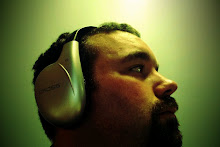I will apologize in advance for the really, REALLY simple example images; however, I don't have much time to make them up today and want to get to the meat of the examples!
I'm going to start this off by giving a rudimentary explanation of masks:
Imagine a piece of white paper... using a black marker, in your mind color that paper black.
Now, while still imagining the black piece of paper on the table imagine picking up another, fresh piece of white paper. Inside this white paper we are going to use scissors to cut a circle. We manage to cut a perfect circle in the white paper. It looks fantastic!
We then place the white paper on top of the black paper. Now the paper looks like a white piece of paper with a perfect black circle in the middle of it... Now, in Photoshop you could APPLY this layer mask (which would be like cutting the rest of the paper away from the black circle and throwing the white paper away).
Now, which of the pieces of paper is the mask? That's right! The white piece of paper. Why? Because it sits over the REAL picture (in this case the black colored paper) like you would sit a mask over your face to hide it.
Now imagine we took a yellow piece of paper and cut a star out of it... Not a normal star but one of those cool "POW!" "ZAP!" "BANG!" stars like from the old Batman show... So we cut this out and we place this on top of the white paper with the hole in it. Hmm, it looks like we cut it a bit too large. That's ok. It'll work out just the way we want. This is now your second layer (you already had a first layer with the black paper and the applied mask!). That's right. You've now worked with layers AND with masks... and you haven't even touched the keyboard and mouse.
Ok, so if you're into Photoshop already you'll likely be falling asleep at the wheel at all of this. It's very "high level" or "layman's terms" to what a mask and a layer both are; however, it's this really simple explanation that will give the beginning a MENTAL and VISUAL understanding of what exactly is represented in Photoshop with masks and layers.
Here is a quick animation on how it would look visually with an additional red, shaped layer:
Now that the simple explanation is done, I'll go a bit further into detail with how masks and layers work to get an end result. I apologize for not having images for this post; however, I will create a couple of images tonight and put them up to give a visual to what it is I am talking about.
If you've ever made a collage, then you've made a layered image. Photoshop works with layers much in the same manner. One layer on top of another on top of another on top of another... Where the difference is is that each layer has it's own transparency control. For example, there are two ways you can create a shape in Photohop: You can create a layer that is transparent and then create a shape onto THAT layer... Thus it is almost like putting another layer onto the collage. The alternate option is to create a solid color layer (say... like yellow) and apply a mask in the form of the shape you want to show. One is "permanent" (like cutting the star out of the paper, or creating a shape onto a transparent layer) and one is "non-permanent" (like the white paper with the hole cut in it over the black paper to make it look like a black circle). I don't use the term "temporary" for a reason... It doesn't HAVE to change, but it can. I COULD take the white paper out from the example above and turn it into a square hole and it would change the make up of the image. I COULD also do this with the other method but there would be efficiency loss in the amount of steps that would be necessary to do this.
Well, it looks like it's time to go. I'm sure you are all yelling at your computer screen saying "WHY DIDN'T YOU FINISH THE LESSON!?!" Well, the problem is, the lesson IS finished! It's really that simple. If you think of layers in Photoshop as layers of paper, it really DOES simplify the whole task and makes it really easy to understand how layers and layer masks work in Photoshop.
Questions are always answered as best as they can be and it's wonderful to see interaction with visitors so feel free to write me a note or send me a question. I promise, next lesson will be a heck of a lot more defined. :)
Take care,
B



